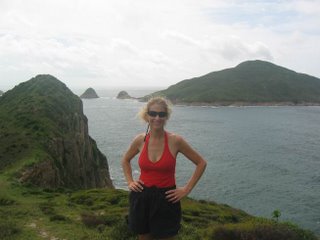Our first foray into Communist China: Guilin and Yangshuo

After 3 weeks of heavy rain with flash flooding and
severe thunder showers we were suffering from a bit of
cabin fever. We were a little down, feeling a bit
like drowned rats so far from friends and family and
were ready for a treat. We also were getting close to
the time when we needed to renew our 3 month visas, so
we decided to take a trip to see something in the
Asia: China, Hong Kong's parent since 1997 and largest
neighbor, being an obvious first choice. For our
first visit into Mainland China, we selected the
Guangxi region in the Southwest because of its unusual
beauty.

We took the plunge and signed up for a tour,
since we'd heard they were pretty reasonable, fitting
the sights into a short time period is tough (even
when you know your way around), our grasp of Mandarin
is non-existent, and we were a little wary of
bureaucracy . . . Getting soft, you see, and that's
our real excuse! We didn't fully grasp how upscale we
were going until we were met individually at the
airport and realized we were on a private tour for
two. A guide, car and driver were at our beck and
call for the duration of our tour. Being pampered was
sure a treat!

The city of Guilin is situated in the center of a
waterway formed by joining two rivers and four lakes,
amidst a landscape dotted with limestone spires rising
haphazardly from the earth. Emperor Hanwu in the West
Han dynasty ordered the Lijian and Xianjiang rivers be
connected by canal in 214 BC, making Guilin an
important town linking the South China sea to Central
China. The dramatic scenery in the region has inspired
poets, painters and photographers for centuries.
During our visit, we saw many art students and artists
in the midst of capturing this beauty in their
drawings and watercolors. The artwork of this area
represents the beauty of China most well known outside
the country.

Just looking at the countryside outside
the car windows while driving between sights was a
pleasure. Steep narrow pinnacles form a beautiful
backdrop to the sights in the near distance and
occasionally interrupt the plains on which the city of
Guilin lies. Interpreting the shapes of various
pinnacles and natural rock formations is common and
most pinnacle names are derived from the shapes they
form. A group of hills together form the shape of a
camel best seen from a distance. Some peaks had
tiny pagodas perched atop them and many had at least
trails winding up to the top for some spectacular
views.
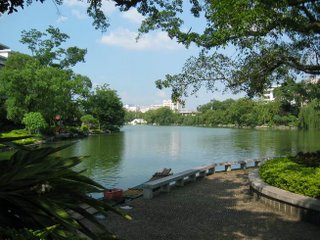
From the Guilin airport, we were whisked past
impressive limestone peaks and a busy city center to
our 4 star hotel where we appreciated the fine view
from our window. We then wandered through the lovely
park surrounding the lake outside before turning in
for the night. The park after dark was lit subtly
with green and blue lights. Benches in the shape of
snoozing pigs brought a smile to our faces. Bridges
mimicking a number of famous bridge styles (Golden
Gate, Florentine, Double Chinese arch, Memorial
bridge, Polaris) stretched over the canals and
connected an island in the center of one lake. Tour
boats plied the waterways across the lakes, passing
under the bridges, and along the rivers and canals
that connected them. Couples strolled along the
walkways and nestled into benches alongside the water
to enjoy its beauty. Cicadas and birds made a natural
symphony. At the center of one of the lakes sit
picturesque tall twin pagodas, one beautifully basked
in bronze light and the other in silver light, called
the Sun and Moon Pagodas respectively, are connected
underwater by an aquarium. Alongside Banyan Lake,
next to huge banyan tree, the old city gate built over
800 years ago during the South Song Dynasty still
stands. Definitely a pleasant intoduction to China.

We started the morning with a generous buffet of the
usual western breakfast items and fresh fruit plus a
number of Chinese favorites, such as congee, noodles,
steamed dumplings and steamed buns. Then our tour
guide, Lucy, met us and led us to the waiting car and
we were off and running to fit in the major sights.
While the sights were very interesting, possibly
moreso was the pure natural beauty of the area and
gaining exposure to a communist country about which we
have heard so many rumors but in fact know so little.
What surprised us was how modern, prosperous, and
capitalistic the area seemed. As casual travellers,
we could detect no difference between the capitalistic
system under which we operate and the actual
manifestation of what we had been taught would be an
"oppressive" Communistic environment. Although
occasionally we saw photos and paintings of Chairman
Mao on walls in people's homes, most people seemed
keen to work hard and earn money. Local people seemed
relaxed and good humored. People dressed in many of
the latest fashions as they might in middle class USA
and a number carried cell phones. While few Chinese
generally wear any makeup (even in Hong Kong), we did
see some, along with obvious hair coloring and
permanent haircurling to make themselves look less
plain. Also like in Hong Kong, people used umbrellas
to keep cooler in the heat of the day and to protect
their pale skin. Also common are hats with veils and
arm coverings to cover the skin between short sleeves
and their hands. (In China, paler skin is still
considered a sign of prestige indicating you are not a
manual laborer. We've laughed when we've seen people
out sailboat racing dressed like Lawrence of Arabia.)
Bicyles, mopeds and motorcycles were everywhere, as
were cars of a variety of makes including VW and
Honda. Although there were no skyscrapers like in
Hong Kong (the marshy earth in the area is not
suitable for supporting tall buildings), we did see
countless businesses with neon and brightly painted
signs, advertisements as well as some new fancier
buildings and luxury townhouses and some detached
houses. I expected to see more signs of poverty after
hearing about the starving people in China from my
mother when I didn't finish my meals as a child.
("You're welcome to mail it to them" I'd smartly quip
back, to her shagrin). Nearly all of our meals were
included in our travel package and delicious food was
proffered in such abundance that we ran out of room on
the table to put it all and couldn't possibly finish
everything, though we did our best. While we did see
the occasional disfigured person and beggar, it seemed
to be a lower proportion than we might encounter in an
average American city these days. Being a tourist
area, foreigners were everywhere (British, French,
Spanish, Japanese, Korean, and Hong Kong Chinese in
particular) in Guilin and Yangshuo, and few locals
paid us much attention unless directly involved in the
tourist trade at sights we were visiting. From what I
hear that has changed in recent years and we were
given a little more notice in the less populated, more
remote areas we visited.

Our official sightseeing began in Guilin with a visit
to Elephant Trunk Hill, a hill shaped much like an
elephant at the convergence of two rivers. The trunk
was formed by a double cave cut through from two
directions. Our guide described how the cut out
between the "trunk" and the "elephant body" forms
another moon on the still water at night, a phenomenon
beautifully described in a famous poem of the Song
dynasty. At the river's edge, past the street
hawkers, we saw bamboo rafts used for traversing and
fishing the flat, sometimes fast moving river using
bamboo poles to propel the rafts. Sitting upon some
of the rafts rested 2 cormorants used to catch fish on
behalf of the fishermen. After appreciating the
striking elephant rock formation from afar, we
ventured across the river and around the hill to
explore inside the cave that seperates the trunk from
the body and see the inscriptions housed within. In
the park along the way, we saw many retired people
practicing the slow body movements of Tai Chi, playing
tradtional instruments and singing, playing on the
swings and playing cards.

We visited Flute Reed Cave, an incredibly large cave
which could contain more than 3000 people. During
WWII bombing the cave was used as an air raid shelter.
The height and depth of the cave is such that no
natural light could penetrate into it. Blue and green
lights were placed behind stalagmites, to create an
attractive indirect backlighting effect. A wide open
area with a high flat overhead had the feeling of a
ballroom, was nicknamed "the Crystal Palace" and was
lit accordingly, with floodlights on a "chandelier"
shaped stalagtite at the center of the huge overhead.
Despite the occasional lighted signs interrupting the
darkness to indicate steps and highlight paths and
forbidden areas and the sound of tourguides of larger
groups in the vicinity calling attention to various
shapes, the vast darkness had an eerie feel. Not
quite like the natural caves we've explored alone with
just a flashlight and our own imaginations, but
impressive in a different way due to its vastness, the
effect of the back lighting and the perspective we
gained from hearing the various shapes interpreted in
ways unique to Chinese culture. Drips from above
added to the effect and reminded us that the cave is
still in the process of changing. The stalagtites
took the form of curtains hanging from overhead and
the stalagmites had the appearance of broccoli florets
as they reach up towards the roof with the build up of
limestone deposites over time. The vast number of
pinnacles in the region and the likelihood of caves at
the base of each suggests some fantastic natural cave
exploring for one who has time, a flashlight and the
inclination.
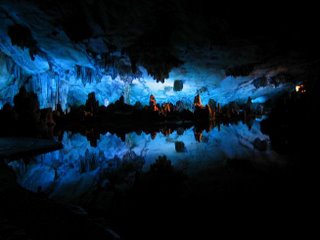
We continued on to Fu Bo Hill, where at its base we
saw caves housing nearly 1000 buddhas and engravings
carved in the style of various dynasties into the
caves therein. Nearby sat an ancient cast iron pot
large enough to feed 1000 men, which demonstrates the
skill of Chinese casting so long ago. We then visited
carvings on the cave at the base of another pinnacle,
Solitary Beauty Peak, that came from a charming story
of the Empress and the emergence of a Chinese marking
in her honor by a faithful servant. We then saw the
Princes palace from the 14 century, now a peaceful
teacher's college which apparently we visited on
graduation day, since we saw a number of people in cap
and gown taking photos. Our tour guide wove stories
and myths of China's long and rich history and made us
acutely aware of our ignorance.

We stopped in to see an art gallery of nice watercolor
and oil paintings and scrolls done by various
professors at the college, where we were strongly
encouraged to buy, but managed to avoid adding to our
collection of framed artwork which already exceeds the
number of walls of your average house. We also
stopped in to a pearl museum where we learned about
the fresh and saltwater pearls grown in the Pearl
River delta and how they differ from the salt water
ones we saw in French Polynesia. We visited a silk
factory outlet where we saw demonstrations of two
methods of silk making: unwinding silk threads (up to
1800 meter long nearly invisible threads can come from
a single cocoon or crysalis the size of a cotton ball)
used for making fine silk garments and tapestries;
and another method of gently stretching the silk
crysalis after extracting the silk worm to create a
lining for duvet bed comforters. The silk worms that
eat the finest mulberry leaves grow stronger to
produce twice the silk. While our tour guides
suggested additional stops beyond the original
itinerary, we were content to spend some time
wandering around Guilin on our own, enjoying the
pretty scenery.
The Guangxi region first came under Chinese rule in
214 BC when armies occupied parts of the area, however
it never came fully firmly under Chinese control.
China encompasses large number of ethnic minorities,
which we hadn't fully grasped before our visit. A
popular saying (even in Hong Kong) is "The mountains
are high and the Emperor is very far." Many ethnic
minorities and hill tribes, some of whom were driven
to this area from their original homes elsewhere,
never assimilated with the occupiers. They retained
their cultural heritage and traditional ways and
dress. We had several opportunities to see a
celebration of the ethnic diversity of the area. The
first was during a fine dinner feast which included
many dishes of food. Sometimes we weren't always sure
what we were eating (a gelatinous cold flavorless soup
immediatley comes to mind), but most dishes were tasty
and recognizeable, including steamed whole fish in a
flavorful broth; pork and beef slices with a peppery
garnish; delicious noodles with bits of pork, pickled
green beans, dried chilies, peanuts and green onions
sprinkled on top; and always lots of fresh fruit for
desert and beer or whatever we wanted to drink in
addition to tea. During dinner, musicians played
traditional instruments, one of which had the twang of
a banjo but was much smaller with a rounded base made
from a natural gourde. Also as we dined, a pretty
young gal sang Chinese Opera very pleasantly, although
the Chinese Opera sound still reminds me of strangling
a cat, with their different tuning scale. A group of
4 young dancers gracefully demonstrated ethnic dances
in costume. One ethnic costume and dance style (like
that of a belly dancer with a short midriff top and
low flowing pantaloons and a gold headress) called to
mind the old M&M commercial from the 70s with 10 arms
all feeding M&Ms into the mouth of a single woman
seated in the lotus position. Though we thoroughly
enjoyed this dinner show, we soon realized this was
just a warm up. After dinner, we strolled the
pedestrian walkway past the lit Sun and Moon Pagodas
to the theater for the real show. The theater
performance really wowed us. We were awed by the
elaborate sets and costumes, singing, dancing and
impressive acrobatic feats in a celebration of ethnic
culture. Acrobats created inumerable forms of human
pyramids demonstrating awesome balance, flexibility,
and strength. The traditional dress of the Miao
people, whom we saw represented a number of times in
various settings, feature attractive long velvet
dresses with tin headresses and tin breastplates. The
Dong, who we also saw several times, wore red or pink
silk clothing and wide brimmed hats with tassles that
would easily offend my peripheral vision. Following
the performance, the audience was able to take
photographs with the performers and see the costumes
up close.

The following day, we had an ideal opportunity to
enjoy the scenic landscape as we cruised down the
river on a ferry boat to the smaller town of Yangshuo,
roughly 40 miles south of Guilin. The river winding
through stunning limestone peaks that reach into the
air made for a photographer and nature lover's dream.

On the back deck of the ferries, cooks would whip up
lunch over a wood stove and accept deliveries from
bamboo rafts that would pull alongside. Watching the
bamboo rafts in action was fascinating. In a bit of
derring, two people would paddle as fast as they could
to match the speed of the ferry and counter the fast
current to come alongside, using a grapnel hook to
attach to the ferry railings. Poor timing could
easily be disastrous and I held my breath a few times
wondering if they would make it. Besides the food
vendors, souvenir hawkers would do the same manuever,
pulling their wares out of a basket in the center of
the bamboo raft to show through the windows to
tourists seated at tables inside.

We motored past another of the largest and longest caves along
our route, where smaller vessels could venture inside. At
a sharp bend in the river, the scenery was
breathtaking, with a dense line of bamboo blowing
gently along the shores and beautiful reflections in
the still waters there. We saw the pretty pinnacle
scene depicted on the back of the 20 Yuan note. At
another bend in the river where there was shoaling, we
passed the old fishing village of Xingping Town, which
we later visited by land.

We spent most of the trip
outside on the top deck, but went inside to join a
group of Japanese tourists for lunch. As we've
discovered on many occasions during the last few
months, a large group Chinese family style meal truly
tests our chopstick skills as we try to get enough to
eat and keep our portions on a tiny plate without
making too big a mess; Without serving utensils,
everyone reaches across each other to take a portion
from communal bowls far across the table using the
chopsticks they've put into their mouths. Yet no one
seems to mind. And everyone dribbles a bit on an
overly crowded table.
After several hours on the river, we reached Yangshuo,
a charming town, nestled into a bend in the river.
The riverboats landed at one of two stone piers, one
for boats with locals and one for those with
foreigners (gwailos - foreign devils). (So far in our
travels, we remember being called gringos (Mexico),
haolies (Hawaii), palangi (Tonga), pakeha (New
Zealand) and we forget what else.) We've already
noticed in Hong Kong that gwailos are treated
differently and, depending on the situation, the price
can be higher for gwailos if you don't know what the
going rate ought to be or check a price in advance.
Once we docked at Yangshuo, we wound our way up the
hill on a narrow pedestrian stone street, called
Western or Foreigner Street, past charming old 2-3
story buildings filled with nice souvenirs and
attractive restaurants that appeal to the
sophisticated traveller. The predominant architecture
was an old style plaster with painted black wood
latticework windows and crossbeams topped by a peaked
tile roof in the traditional Chinese style.

At the top of the street, we turned and went through a
stone gate and over a bridge into our charming, yet
small hotel complex of buildings, pathways, and
waterways. As we checked into the hotel we saw photos
on the wall of several US Presidents and First Ladies
who had stayed here such as Richard and Patricia
Nixon, Jimmy and Roslyn Carter, George and Barbara
Bush, and Bill and Hilary Clinton as well as leaders
of China and various other countries, the UN and other
NGOs. From our room, we had another nice view of the
spires in the distance.

After cooling down and relaxing for a bit, we rented
bicycles and headed for the countryside for a little exploring.

We rode past rice paddies and fields of various colors surrounded
by square low stone walls/pathways and marvelled at
the layers of pinnacles behind them for as far as we
could see. Power lines criss crossed the plains in
the near distance. Single or two story small stone
and brick buildings with tile peaked roofs dotted the
landscape. The buildings had windows but outside of
town rarely had window glass. Along the road, we saw
people in peaked hats carrying baskets loaded with
produce and even piglets balanced on bamboo rods
across their shoulders.
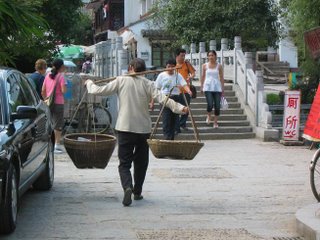
Water buffalo sauntered by with a little urging from their herders.

Countless tour buses whisked past us as did small trucks with
little utility engines using belt drives to propel a
single front wheel.

Moon Hill loomed above us, famous
for its half circle hole which waxes and wanes as you
shift your viewing angle.
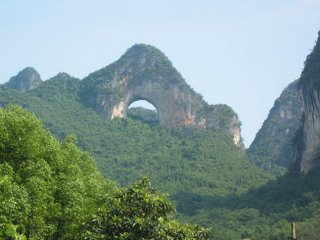
As we headed across one field perpendicular to
the main road, we reached the river south of
Yangshuo town, where bamboo rafts lined the banks.

We attended an outdoor evening show which featured
more than 600 performers and hundreds of bamboo rafts.
Lights on a few of the nearest peaks, created a
remarkable backdrop behind a small group of docks
which enclosed still flat water to form a stage. The
show, from the director of the movie "Raise the Red
Lantern", used costumes, music, lights, shapes, fabric
and colors, cormorants, fishnets, and torches of fire
through the coordinated movement of hundreds of
performers and rafts to create poetic illusions and
tell stories of the ethnic peoples of the area.
A visit to Xingping town, which we had seen along the
river, showed us the more traditional life of a sleepy
fishing village. Narrow cobble streets separated tiny
storefront houses. Red banners adorned the doorways
wishing the inhabitants prosperity and good health in
the coming year. Elderly and young alike played cards
in the shade of a large tree, inside someone's home or
on a street corner. Bamboo rafts plied the river,
fishing for a good catch. People cooked on wood
burning stoves outside and hand pumped their water
from an old style well along the town street. The
town could have been exactly the same over 100 years
ago, except that power lines and utility meters are
visible along the street and a soap opera blared from
a TV beneath a portrait of Chairman Mao.

Passing fields of corn, bok choy, oranges, and brick
factories, we headed to a bigger town, where we
visited a fan workshop run by a woman whose
grandmother and grandfather still painted the scenes
on the fans at 105 and 98 years old! A few people
quietly were working away while the proprietor
explained and demonstrated the process: Silk fabric
in the half circle shape of a fan is hand painted
while another similar piece of silk is spread out flat
using a form of paste to give it stiffness. Both parts
are left to dry. (As we walked around town, we saw
fan silk drying in the sun outside other workshops.)
The two fabric parts are glued together using a guide
to leave unglued strips into which the bamboo
framework will be inserted later. Then the stiff
fabric is folded into pleats and the bamboo frames are
inserted. The end frames are fitted and glued to the
fabric ends, then a nail is hammered into the spot
around which the fan will pivot to open. The labor
intensive process takes 6 weeks for each fan.

We saw some pretty interesting offerings on the menu
in Yangshuo, including fried bee larva with cashews,
local style braised bamboo rat, crispy braised baby
sparrows, buffalo stomach blood heart combo, shredded
pig stomach in red chili sauce, braised duck feet,
braised garlic flavored dog meat, crispy pig feet in
plum sauce and sea kelp knots in red spicy sauce. We
were a bit timid on our food ordering compared to
these offerings but went for the spicy style we love.
We had some fantastic Szechuan dishes (spelled Sichuan
in China and Hong Kong, and pronounced seechuan, we
learned when we realized that no one knew what we were
talking about). The heat of these dishes caused us to
burn through several beers. Our favorite dishes were
a couple of Yangshuo recipes: "beer fish", which
consisted of 2 whole steamed fish over a spicy red
broth that we just about drank, and garlic pork
stuffed snails in a spicy brownish red sauce, and
crunchy fried whole snack shrimp. As ever the
portions were overly generous and the table way too
small, but the feasts were priceless.
What a fantastic trip! We had ideal weather and the
scenery was incredible. The food and the service was
an indulgence. Good for the soul after a bit of
camping out!



